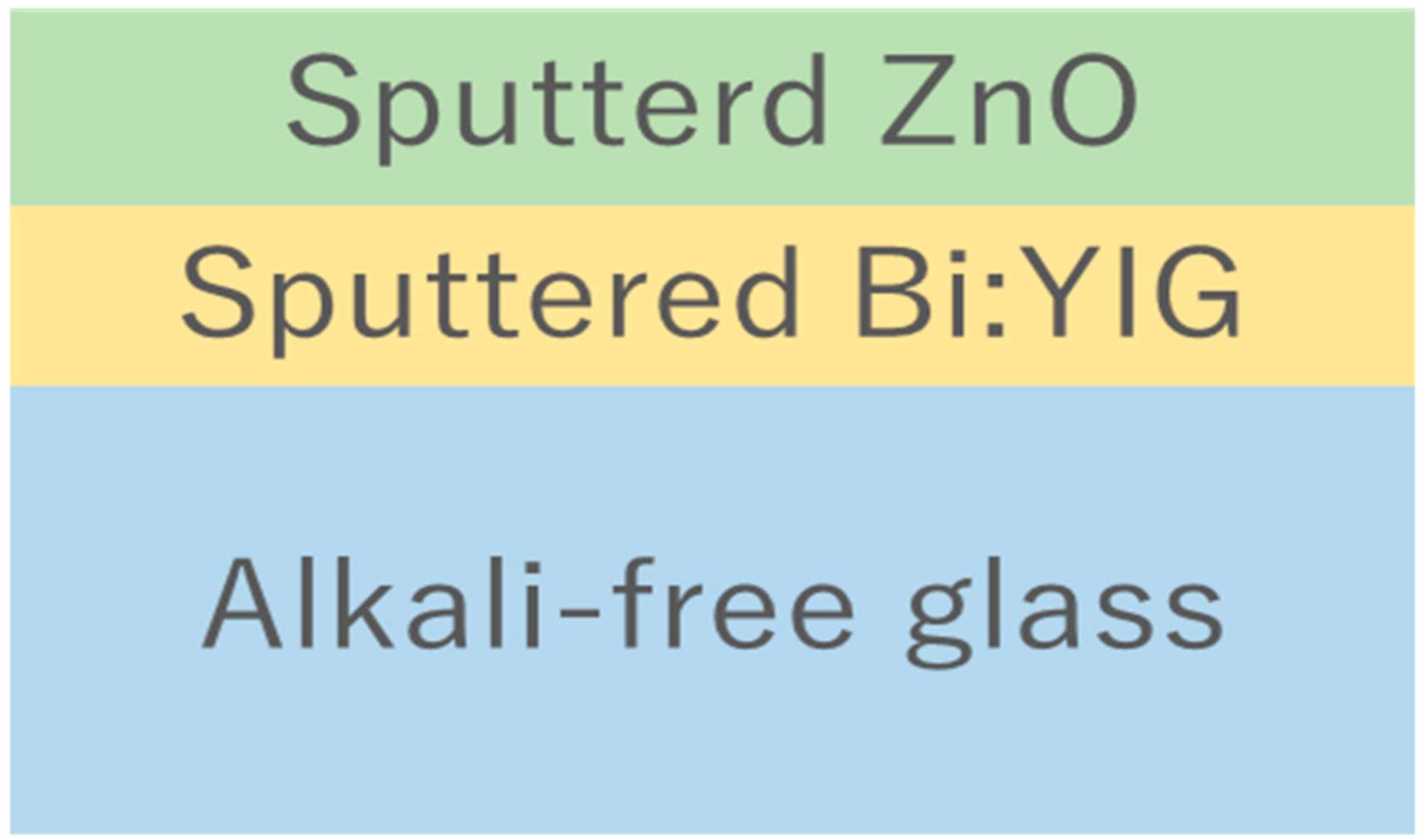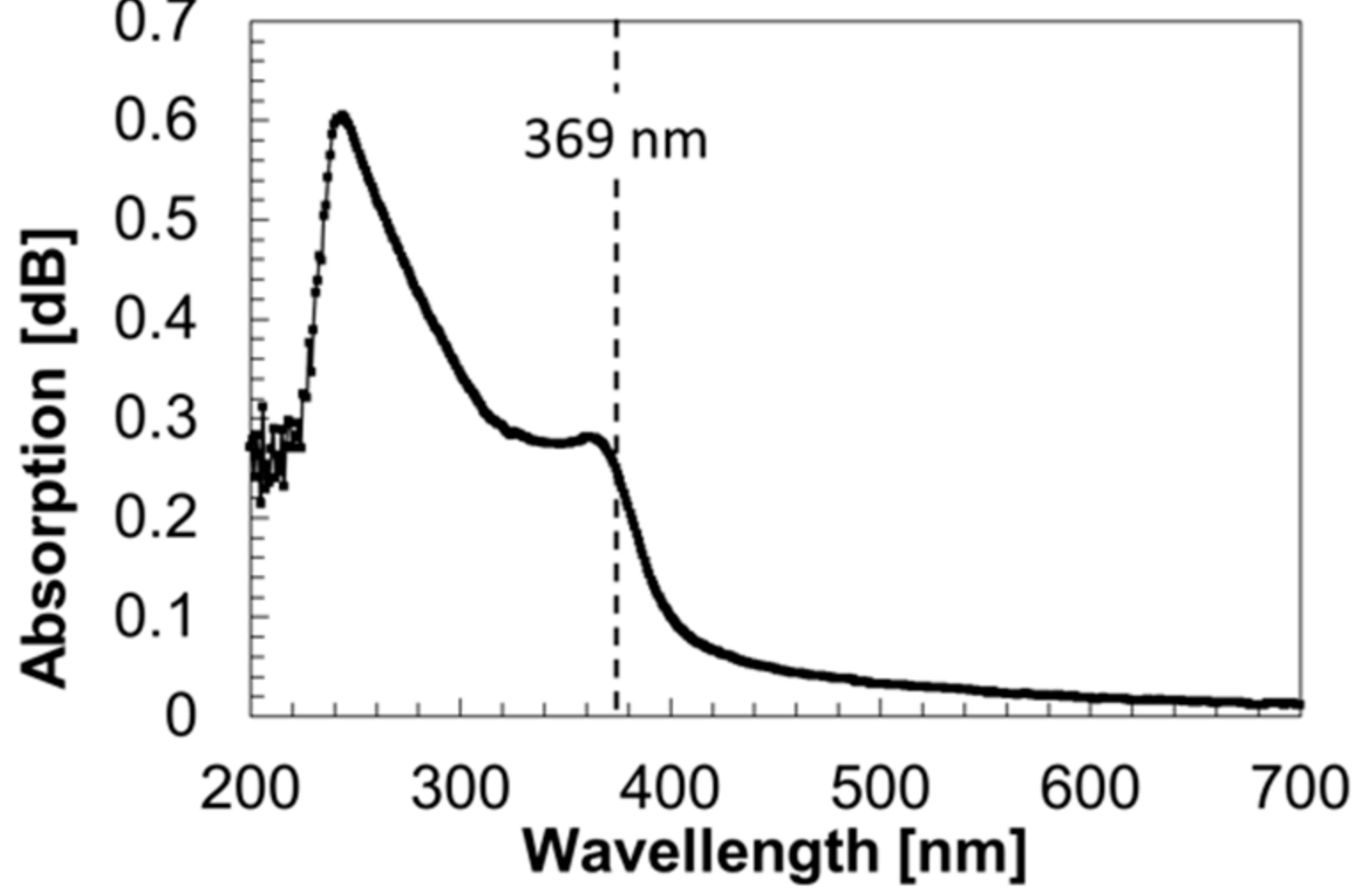Influence of Sputtered ZnO and Al:ZnO Top Layers on Magneto-Optic Responses of Yttrium Iron Garnet Films
Abstract
:1. Introduction
2. Materials and Methods
3. Results and Discussion
3.1. Bi:YIG Film with a ZnO Top Layer
3.2. Bi:YIG Film with an Al-Substituted ZnO Top Layer
4. Conclusions
Author Contributions
Funding
Conflicts of Interest
References
- Fujikawa, R.; Baryshev, A.V.; Kim, J.; Uchida, H.; Inoue, M. Contribution of the surface plasmon resonance to optical and magneto-optical properties of a Bi:YIG-Au nanostructure. J. Appl. Phys. 2008, 103, 07D301. [Google Scholar]
- Uchida, H.; Masuda, Y.; Fujikawa, R.; Baryshev, A.V.; Inoue, M. Large enhancement of Faraday rotation by localized surface plasmon resonance in Au nanoparticles embedded in Bi:YIG film. J. Magn. Magn. Mater. 2009, 321, 843–845. [Google Scholar] [CrossRef]
- Uchida, K.; Adachi, H.; Kikuchi, D.; Ito, S.; Qiu, Z.; Maekawa, S.; Saitoh, E. Generation of spin currents by surface plasmon resonance. Nat. Commun. 2014, 6, 5910. [Google Scholar] [CrossRef] [PubMed]
- Inoue, M.; Arai, K.; Fujii, T.; Abe, M. One-dimensional magnetophotonic crystals. J. Appl. Phys. 1999, 85, 5768–5770. [Google Scholar] [CrossRef]
- Lyubchanskii, I.L.; Dadoenkova, N.N.; Lyubchanskii, M.I.; Shapovalov, E.A.; Rasing, T. Magnetic Photonic crystals. J. Phys. D Appl. Phys. 2003, 36, R277. [Google Scholar] [CrossRef]
- Inoue, M.; Fujikawa, R.; Baryshev, A.; Khanikaev, A.; Lim, P.B.; Uchida, H.; Aktsipetrov, O.; Fedyanin, A.; Murzina, T.; Granovsky, A. Magnetophotonic crystals. J. Phys. D Appl. Phys. 2006, 39, R151. [Google Scholar] [CrossRef]
- Ha, D.T.; Thuy, D.T.; Hoa, V.T.; Van, T.T.T.; Viet, N.T. On the theory of three types of polaritons (phonon, exciton and plasmon polaritons). J. Phys. Conf. Ser. 2017, 865, 012007. [Google Scholar] [CrossRef] [Green Version]
- Özgür, Ü.; Alivov, Y.I.; Liu, C.; Teke, A.; Reshchikov, M.A.; Doğan, S.; Avrutin, V.; Cho, S.-J.; Morkoç, H. A comprehensive review of ZnO materials and devices. J. Appl. Phys. 2005, 98, 041301. [Google Scholar] [CrossRef]
- Xiong, G.; Wilkinson, J.; Ucer, K.B.; Williams, R.T. Time-of-flight study of bound exciton polariton dispersive propagation in ZnO. J. Phys. Condens. Matter 2005, 17, 7287. [Google Scholar] [CrossRef]
- Mito, S.; Yusaku, S.; Sasano, J.; Takagi, H.; Inoue, M. Enhancement of magnetic circular dichroism in bi-layered ZnO-Bi:YIG thin films. AIP Adv. 2017, 7, 056316. [Google Scholar] [CrossRef] [Green Version]
- Chakraborty, T. Quantum Dots-A Survey of the Properties of Artificial Atoms; Elsevier: Amsterdam, The Netherlands, 1999. [Google Scholar]
- Miller, D.A.B; Chemla, D.S.; Damen, T.C.; Gossard, A.C.; Wiegmann, W.; Wood, T.H.; Burrus, C.A. Band-edge electroabsorption in quantum well structures: The quantum-confined stark effect. Phys. Rev. B Condens. Matter 1985, 32, 1043. [Google Scholar] [CrossRef] [PubMed]
- Collins, R.T.; Viña, L.; Wang, W.I.; Chang, L.L.; Esaki, L.; Klitzing, K.V.; Ploog, K. Mixing between heavy-hole and light-hole excitons in GaAs/AlxGa1-xAs quantum wells in an electric field. Phys. Rev. B Condens. Matter 1987, 36, 1531. [Google Scholar] [CrossRef] [PubMed]
- Miller, D.A.B.; Chemla, D.S.; Damen, T.C.; Gossard, A.C.; Wiegmann, W.; Wood, T.H.; Burrus, C.A. Electric field dependence of optical absorption near the band gap of quantum-well structures. Phys. Rev. Lett. 1984, 53, 2173. [Google Scholar] [CrossRef]
- Minami, T.; Nanto, H.; Takata, S. Highly Conductive and Transparent Aluminum Doped Zinc Oxide Thin Films Prepared by RF Magnetron Sputtering. Jpn. J. Appl. Phys. 1984, 23, L280–L282. [Google Scholar] [CrossRef]
- Chen, Y.-Y.; Wang, P.W.; Hsu, J.-C.; Lee, C.-Y. Post-annealing properties of aluminum-doped zinc oxide films fabricated by ion beam co-sputtering. Vacuum 2013, 87, 227–231. [Google Scholar] [CrossRef]












© 2018 by the authors. Licensee MDPI, Basel, Switzerland. This article is an open access article distributed under the terms and conditions of the Creative Commons Attribution (CC BY) license (http://creativecommons.org/licenses/by/4.0/).
Share and Cite
Mito, S.; Kikuchi, S.; Ito, Y.; Ota, N.; Inoue, M. Influence of Sputtered ZnO and Al:ZnO Top Layers on Magneto-Optic Responses of Yttrium Iron Garnet Films. Crystals 2018, 8, 396. https://doi.org/10.3390/cryst8100396
Mito S, Kikuchi S, Ito Y, Ota N, Inoue M. Influence of Sputtered ZnO and Al:ZnO Top Layers on Magneto-Optic Responses of Yttrium Iron Garnet Films. Crystals. 2018; 8(10):396. https://doi.org/10.3390/cryst8100396
Chicago/Turabian StyleMito, Shinichiro, Satsuki Kikuchi, Yasutoshi Ito, Nana Ota, and Mitsuteru Inoue. 2018. "Influence of Sputtered ZnO and Al:ZnO Top Layers on Magneto-Optic Responses of Yttrium Iron Garnet Films" Crystals 8, no. 10: 396. https://doi.org/10.3390/cryst8100396
APA StyleMito, S., Kikuchi, S., Ito, Y., Ota, N., & Inoue, M. (2018). Influence of Sputtered ZnO and Al:ZnO Top Layers on Magneto-Optic Responses of Yttrium Iron Garnet Films. Crystals, 8(10), 396. https://doi.org/10.3390/cryst8100396



